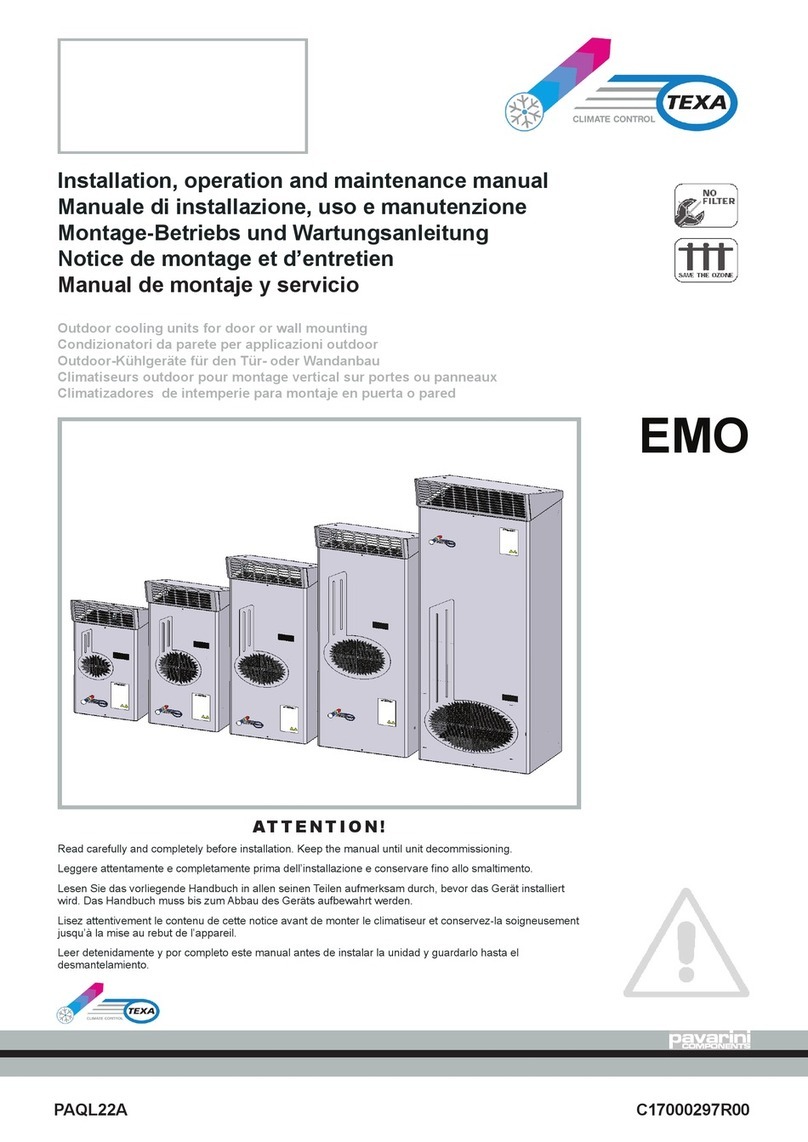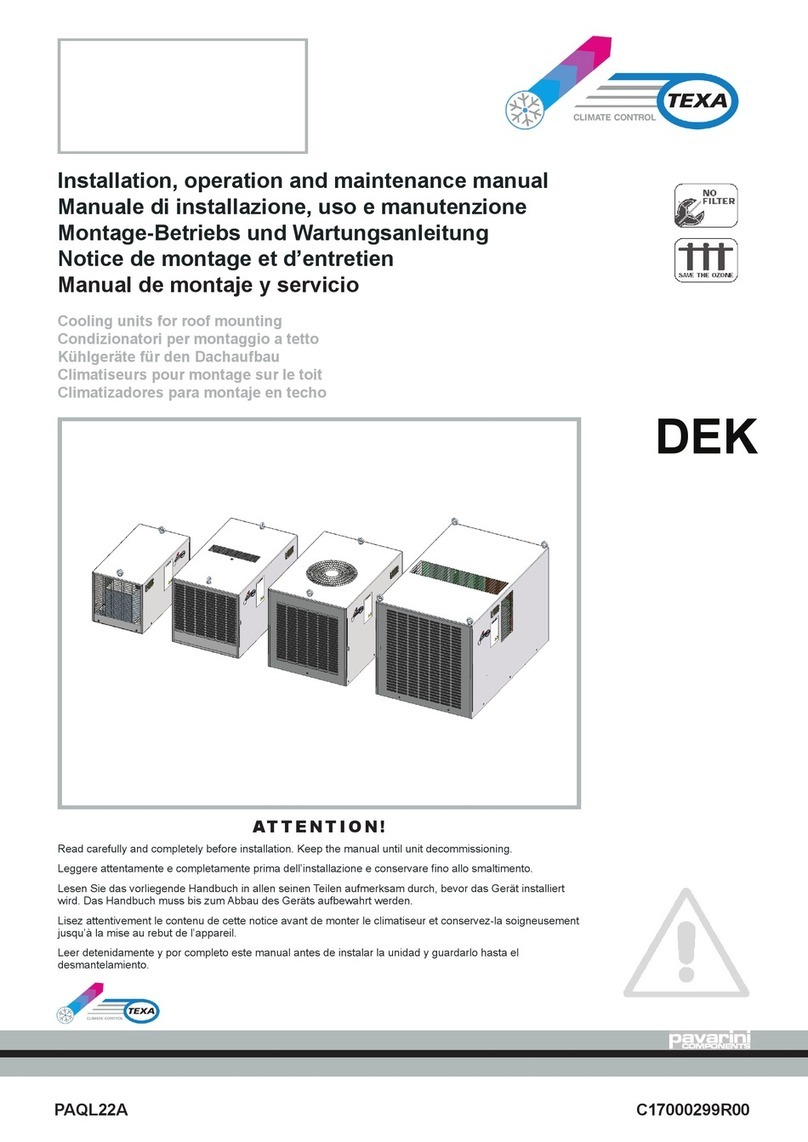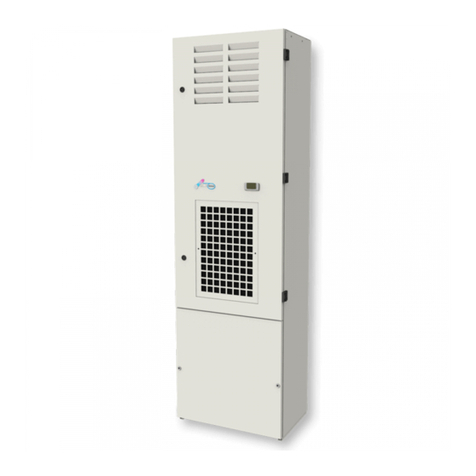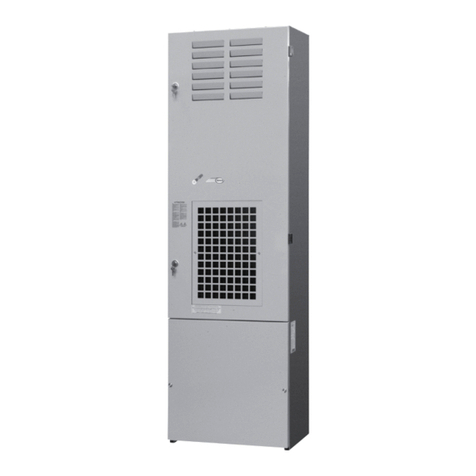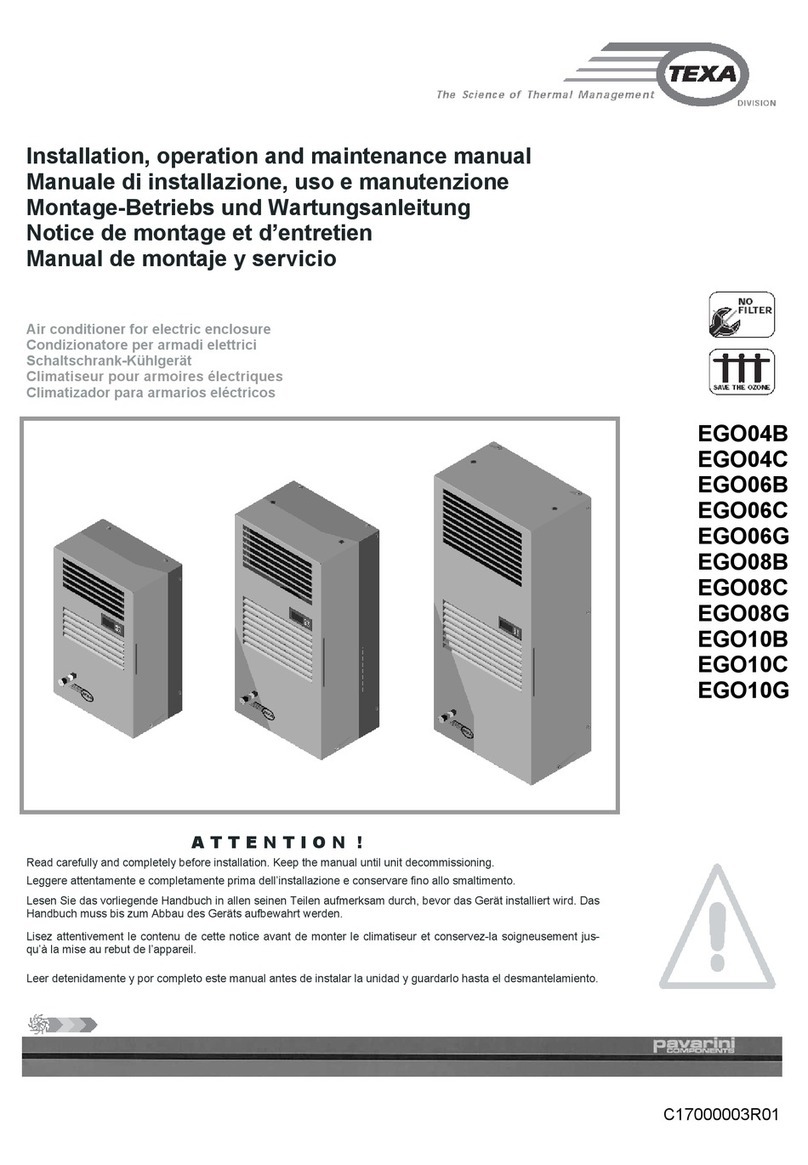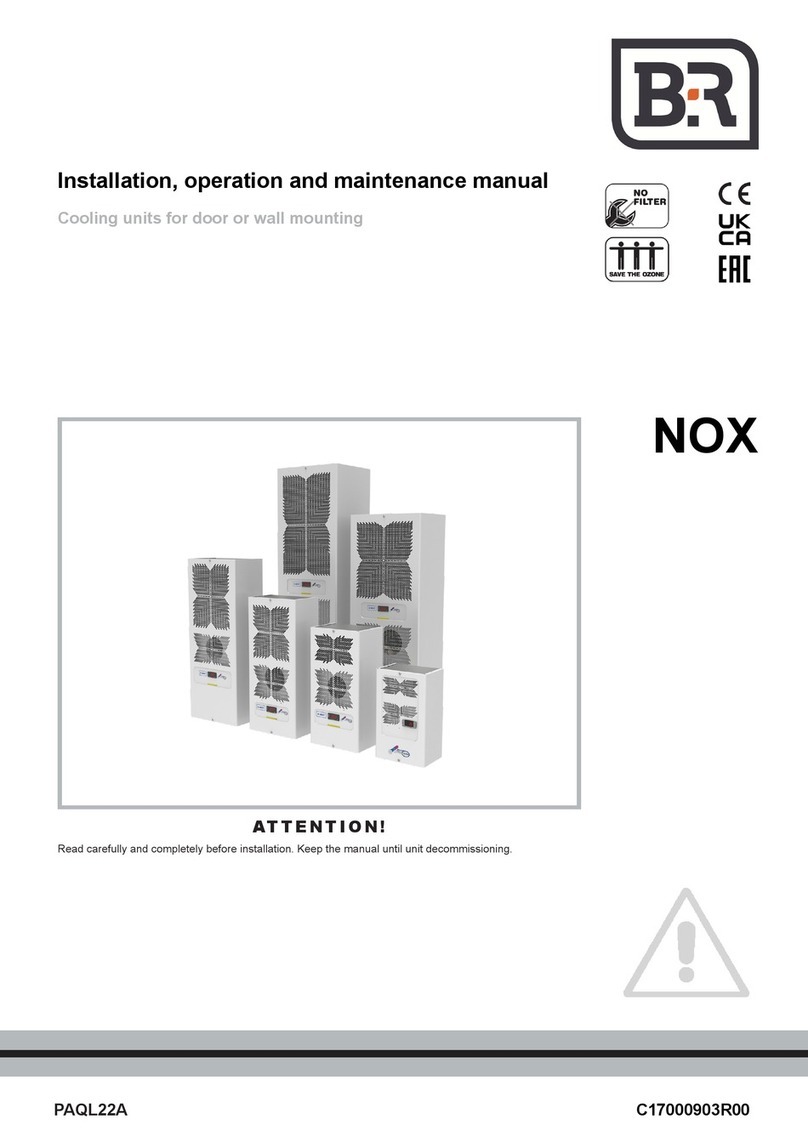6
ITA
1. Introduzione
Questo manuale contiene informazioni di carat-
tere generale valide per tutti i modelli della gam-
ma EMO. Ulteriori informazioni quali disegni di-
mensionali, dati tecnici, schemi elettrici sono in-
seriti nell’allegato tecnico rilasciato per ogni sin-
gola unità.
2. Destinazione d’uso e limiti di funziona-
mento del condizionatore.
I condizionatori descritti in questo manuale so-
no progettati e realizzati per il raffreddamento
dell’aria contenuta all’interno dei quadri di co-
mando da esterno, al ne di proteggerne i com-
ponenti sensibili alle sollecita zioni termiche e,
nello stesso tempo, forniscono una protezione
IP54 contro l’ingresso di sostanze contaminanti
e di agenti aggressivi. Per un corretto funziona-
mento del condizionatore la temperatura dell’aria
esterna deve essere compresa tra un minimo di
-20°C ed un massimo di +50°C (+55°C per le
unità per cui espressamente indicato sulla tar-
ga dati).
3. Aggiornamenti.
La Pavarini Components si riserva il diritto di ag-
giornare i prodotti ed i relativi manuali senza pre-
avviso, in base al progresso della tecnica. Di
con tro, al momento della commercializzazione,
il presente manuale ed il relativo prodotto non
possono essere considerati inadeguati solo per-
ché non aggiornati col progresso di cui sopra.
4. Fornitura
Nell’imballo sono contenuti:
condizionatore
manuale di installazione, uso e manu
tenzione
certicato di con formità CE
certicato di collaudo
dadi
rondelle piane
grani
nastro di guarnizione autoadesiva 10x5 mm
spezzone tubo essibile per scarico
condensa 12x2x100 mm
(gura F.7)
(gura F.9)
5. Prima del montaggio
Durante il trasporto e l’immagazzinamento il
condizionatore deve essere mantenuto nel-
la posizione chiaramente indicata sull’im-
ballo (gura F.1) e non deve essere espo-
sto a temperature superiori a 70°C.
Al ricevimento, controllare che l’imballo non
presenti danni da trasporto.
La temperatura dell’aria ambiente, nel si-
to di installazione dell’armadio, non deve
su perare i 50°C e, in ogni caso, non deve
essere superiore alla massima temperatura
di esercizio del condizionatore, speci cata
nella targa dati dello stesso. Posizionare il
condizionatore in modo da rimanere lontani
da fonti di calore o ussi di aria calda.
Vericare che il quadro abbia un grado IP54
o superiore. In caso contrario si potrebbe
ve ricare formazione eccessiva di conden-
sa. Di conseguenza, sigillare bene le zone
di passaggio cavi ed eventuali altre apertu-
re nell’armadio.
Vericare che l’ambiente esterno non pre
senti concentrazioni di contaminanti solidi
e/o di contaminanti chimici aggressivi in mi-
sura eccessiva.
Vericare che i ussi di aria in ingresso e in
uscita dal condizionatore non siano ostaco-
lati da pareti ed oggetti troppo vicini. A tale
scopo, per quanto riguarda il usso d’aria
esterno, vericare le distanze mi nime (gu-
ra F.2 ), mentre per il usso d’aria interno,
veri care che non vi siano ostacoli derivanti
dai componenti presenti nel quadro.
La tensione di alimentazione disponibile de-
ve rispondere alle caratteristiche riportate
sulla targa dati del condizionatore.
Il condizionatore deve essere installato con
il foro di aspirazione aria armadio nel punto
più alto possibile.
Se il condizionatore deve essere installato
su una porta, accertarsi che questa sia in
grado di sopportarne il peso.
Prima di realizzare i fori e le feritoie sul-
l’armadio, accertarsi che gli elementi di s
saggio e di accoppiamento non andranno
ad interferire con le apparecchiature conte-
nute nell’armadio stesso.
6. Montaggio
Prima di effettuare qualsiasi operazione all’ in-
terno del quadro sconnettere l’alimentazione. Il
condizionatore può essere applicato sull’ arma-
dio elettrico, senza la ne cessità di ulte riori ac-
cessori che non siano quelli presenti nel kit di
montaggio standard in dotazione. Eseguire sul
quadro i fori e i tagli necessari, utilizzando l’ap-
posita dima di foratura fornita. Ap plicare, dove
previsto, la guarni zione al con dizio natore sul lato
di accoppiamento all’armadio e seguire lo sche-
ma di mon taggio in dicato (gura F.7). Per solle-
vare il condiziona tore in sicurezza, si pos sono
utilizzare i due golfari o le due staffe di solleva-
mento nella parte superiore del condizionatore
(gura F.3).
7. Scarico condensa
La condensa che, in funzione delle condizio-
ni di temperatura e umidità ambiente, si forma
sullo scambiatore che raffredda l’aria dell’arma-
dio, non è un’anomalia ma una caratteristica del
funzionamento normale del condizionatore. La
condensa viene portata all’esterno per mezzo
di un tubo nella parte inferiore del condizionato-
re. A questo sca rico, si deve collegare il tubo in
plastica traspa rente parte della fornitura (gura
F.9). Questo tubo in plastica può essere raccor-
dato ad un altro tubo di pari diametro per condur-
re la condensa in altra posizione, in modo che
lo scarico avvenga in area non a rischio di sci-
volamento del personale. In questo caso, assi-
curarsi che la condensa scorra senza ostaco-
li. Evitare tratti oltre 0,5 metri di tubo orizzonta-
le, tratti in contro pendenza e forma zione invo-
lontaria di sifoni (gura F.5). L’estremità del tubo
di scarico della condensa deve sempre essere
libera, mai immersa. Quindi non collocare mai
l’estremità del tubo di scarico all’interno di conte-
nitori di raccolta con densa (gura F.6). Utilizzare
il condizionatore con armadio a porte aperte ge-
nera quantità eccessive di condensa: questa è
una condi zione di utilizzo non autorizzata (gu-
ra F.8). Per prevenire tale inconveniente è consi-
gliato l’utilizzo di un interruttore di posizione sulla
porta che arresti il funzionamento del condizio-
natore in caso di apertura.
8. Collegamento elettrico.
8.1 Sicurezza
Attenzione! Il collegamento elettrico deve es-
sere eseguito da personale specializzato e
autorizzato. Togliere tensione all’armadio pri-
ma di effettuare il collegamento. Controllare
che l’armadio non sia alimentato e che la tensio-
ne corrisponda a quella riportata sulla targa dati
del condizionatore. Allo scopo di garantire la pro-
tezione dell’alimentazione utilizzare opportuni
seziona tori / fusibili o interruttori magneto termici,
con distanza tra i contatti di almeno 3 mm con
contatti aperti secondo le tarature indicate sul-
la targa dati. Eseguire il collegamento dei cavi
secondo quanto indicato nello schema elettri-
co. Il condizionatore dopo una fermata non de-
ve essere reinserito immediatamente. Si consi-
glia pertanto l’uso di un comando temporizzato
che ritardi il reinserimento di 3 minuti. Scolle-
gare il condizionatore prima delle prove di col-
laudo dell’armadio.
8.2 Modelli con autotrasformatore (EMO..G)
Questi modelli bifase sono predisposti per due
tensioni di alimentazione: 440V 2~ 5060Hz e
400V 2~ 50-60Hz. Se l’alimentazione disponibile
è 440V 2~ 50-60Hz collegare i morsetti L1(0) e
L3(440) del connettore nero (gura F.4). Vice-
versa se l’alimentazione disponibile è 400V 2~
50-60Hz collegare L1(0) e L2(400) sul medesi-
mo connettore.
9. Primo avvio e regolazione.
Nel caso che il condizionatore, prima del mon
tag gio, sia stato lasciato in posizione non cor
retta ( gura F.1), attendere almeno 8 ore prima
di met terlo in funzione. Diversamente, 30 minu-
ti saranno sufcienti al ritorno dell’olio nel com-
pressore, do podiché sarà possibile dare tensio-
ne al condizionatore. Il ventilatore che aspira
l’aria dell’armadio, si metterà subito in funzione
uniformando la temperatura interna dell’arma-
dio. Se questa temperatura dovesse essere su-
periore alla soglia impostata sul termostato di re-
golazione, si inseriranno il com pressore e il ven-
tilatore dell’aria esterna determinando l’inizio del
ciclo di raffreddamento. Quest’ultimo terminerà
quando la temperatura interna raggiungerà il li-
mite inferiore del diffe renziale di funzionamento,
che ha un valore sso pari a 4 K. Il termostato
è impostato a 35°C in fabbrica. Per variare il set
di temperatura accedere al termostato. La sca-
la gra duata, da 20 a 46 °C, permette di variare
il set di temperatura secondo il valore desidera-
to (gura F.10). Per il risparmio energetico e mi-
nimizzare la produzione di condensa si consiglia
tuttavia di non scendere al di sotto di 30 °C.
10. Manutenzione.
Attenzione! Prima di eseguire qualsiasi
intervento togliere tensione all’armadio. Il
condizio natore è del tipo a bassa manuten zione,
quindi non richiede sostituzione o cambio del l-
tro. Gli unici interventi richiesti riguardano la puli-
zia dei componenti interni, da effettuarsi con aria
com pressa avente pressione max di 4 bar (gu-
ra F.11) e il controllo periodico, se condo quanto
di seguito riportato:
1
1
1
1
6/8
6/8
6/8
1
1
•
•
•
•
•
•
•
•
•
•
2
3
4
5
1
1
5
4
Intervento
Controllo ed eventuale
pulizia dello scambiatore
di calore aria esterna.
Controllare l’efcienza
dello scarico condensa.
Controllare i ventilatori
per eventuali surris-
caldamenti o eccessive
vibrazioni.
Frequenza
Ogni 3 mesi
Ogni 3 mesi
Ogni 6 mesi












